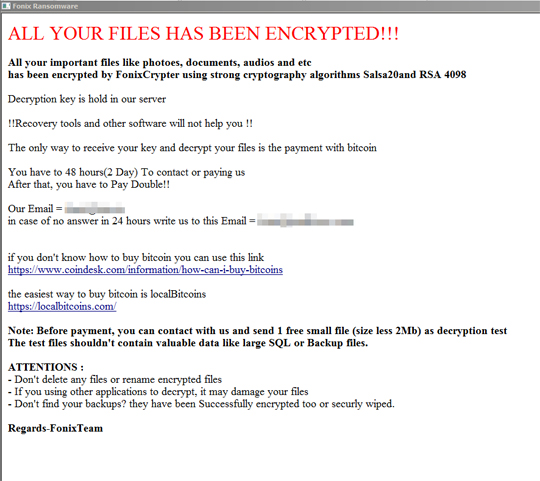Ransom.Win32.FONIX.A
Trojan.Win32.Diss.suvbu (Kaspersky), Trojan.Win32.VMProtect (Ikarus)
Windows


Threat Type: Ransomware
Destructiveness: No
Encrypted:
In the wild: Yes
OVERVIEW
This Ransomware arrives on a system as a file dropped by other malware or as a file downloaded unknowingly by users when visiting malicious sites.
It drops files as ransom note. It avoids encrypting files with the following file extensions.
TECHNICAL DETAILS
Arrival Details
This Ransomware arrives on a system as a file dropped by other malware or as a file downloaded unknowingly by users when visiting malicious sites.
Installation
This Ransomware drops the following files:
- {Malware Path}\systemid
- {Malware Path}\cpriv.key
- {Malware Path}\cpub.key
- %Application Data%\cpriv.key
- %Application Data%\cpub.key
- %Application Data%\systemid
(Note: %Application Data% is the current user's Application Data folder, which is usually C:\Documents and Settings\{user name}\Application Data on Windows 2000(32-bit), XP, and Server 2003(32-bit), or C:\Users\{user name}\AppData\Roaming on Windows Vista, 7, 8, 8.1, 2008(64-bit), 2012(64-bit) and 10(64-bit).)
It adds the following processes:
- reg add HKEY_CURRENT_USER\Software\Microsoft\Windows\CurrentVersion\Policies\System /v DisableTaskMgr /t REG_DWORD /d 1 /f
- reg add \"HKEY_LOCAL_MACHINE\SOFTWARE\Policies\Microsoft\Windows Defender\" /v DisableAntiSpyware /t REG_DWORD /d 1 /f
- reg delete HKEY_CURRENT_USER\System\CurrentControlSet\Control\SafeBoot /va /F
- reg delete HKEY_LOCAL_MACHINE\System\CurrentControlSet\Control\SafeBoot /va /F
- cmd.exe /c vssadmin Delete Shadows /All /Quiet & wmic shadowcopy delete & bcdedit /set {default} boostatuspolicy ignoreallfailures & bcdedit /set {default} recoveryenabled no & wbadmin delete catalog -quiet/ & icacls * /grant Everyone:(OI)(CI)F /T /C /Q
- schtasks /CREATE /SC ONLOGON /TN fonix /TR %temp%/FonixCrypter.exe /RU SYSTEM /RL HIGHEST /F
- reg add HKEY_LOCAL_MACHINE\SOFTWARE\Microsoft\Windows\CurrentVersion\Run\ /v \"PhoenixTechnology\" /t REG_SZ /d %temp%FonixCrypter.exe /f
- reg add HKEY_CURRENT_USER\SOFTWARE\Microsoft\Windows\CurrentVersion\Run\ /v \"PhoenixTechnology\" /t REG_SZ /d %temp%FonixCrypter.exe /f
- reg add HKEY_LOCAL_MACHINE\SOFTWARE\Microsoft\Windows\CurrentVersion\RunOnce\ /v \"PhoenixTechnology\" /t REG_SZ /d %temp%FonixCrypter.exe /f
- reg add HKEY_CURRENT_USER\SOFTWARE\Microsoft\Windows\CurrentVersion\RunOnce\ /v \"PhoenixTechnology\" /t REG_SZ /d %temp%FonixCrypter.exe /f
It adds the following mutexes to ensure that only one of its copies runs at any one time:
- FakeMutex
- FonixCryptServiceMUTEX
Process Termination
This Ransomware terminates the following processes if found running in the affected system's memory:
- sqlservr.exe
- msftesql.exe
- sqlagent.exe
- sqlbrowser.exe
- sqlwriter.exe
- oracle.exe
- ocssd.exe
- dbsnmp.exe
- synctime.exe
- mydesktopqos.exe
- agntsvc.exe
- isqlpplussvc.exe
- isqlpussvc.exe
- xfssvccon.exe
- mydesktopservice.exe
- ocautoupds.exe
- encsvc.exe
- firefoxconfig.exe
- tbirdconfig.exe
- ocomm.exe
- mysqld.exe
- mysqld-nt.exe
- mysqld-opt.exe
- dbeng50.exe
- sqbcoreservice.exe
- excel.exe
- infopath.exe
- msaccess.exe
- mspub.exe
- onenote.exe
- outlook.exe
- powerpnt.exe
- stream.exe
- thebat.exe
- thebat64.exe
- Thunderbird.exe
- visio.exe
- winword.exe
- wordpad.exe
- notepad.exe
- paint.exe
- notepad++.exe
- endnote.exe
- vmwareuser.exe
- vmwareservice.exe
- vboxservice.exe
- vboxtray.exe
- Sandboxiedcomlaunch.exe
- procmon.exe
- regmon.exe
- filemon.exe
- wireshark.exe
- netmon.exe
- ntoskrnl.exe
- vmtoolsd.exe
Ransomware Routine
This Ransomware avoids encrypting files with the following strings in their file name:
- SytemID
- Boot
- boot
- BOOT
- SYSTEM
It appends the following extension to the file name of the encrypted files:
- .EMAIL=[fonix@tuta.io]ID=[{ID}].Fonix
It drops the following file(s) as ransom note:
- {Path of Encrypted File}\# How To Decrypt Files #.hta

It avoids encrypting files with the following file extensions:
- .exe
- .dll
- .sys
- .ini
- .cfg
- .bin
- .msi
- .efi
- .sti
- .reg
- .EXE
- .ecs
- .ocx
- .cpl
- .xslt
- .config
- .DLL
- .boot
- .INI
- .CFG
SOLUTION
Step 1
Trend Micro Predictive Machine Learning detects and blocks malware at the first sign of its existence, before it executes on your system. When enabled, your Trend Micro product detects this malware under the following machine learning name:
-
Troj.Win32.TRX.XXPE50FFF036
Step 2
Before doing any scans, Windows 7, Windows 8, Windows 8.1, and Windows 10 users must disable System Restore to allow full scanning of their computers.
Step 3
Note that not all files, folders, and registry keys and entries are installed on your computer during this malware's/spyware's/grayware's execution. This may be due to incomplete installation or other operating system conditions. If you do not find the same files/folders/registry information, please proceed to the next step.
Step 4
Identify and terminate files detected as Ransom.Win32.FONIX.A
- Windows Task Manager may not display all running processes. In this case, please use a third-party process viewer, preferably Process Explorer, to terminate the malware/grayware/spyware file. You may download the said tool here.
- If the detected file is displayed in either Windows Task Manager or Process Explorer but you cannot delete it, restart your computer in safe mode. To do this, refer to this link for the complete steps.
- If the detected file is not displayed in either Windows Task Manager or Process Explorer, continue doing the next steps.
Step 5
Search and delete these files
- {Malware Path}\systemid
- {Malware Path}\cpriv.key
- {Malware Path}\cpub.key
- %Application Data%\cpriv.key
- %Application Data%\cpub.key
- %Application Data%\systemid
Step 6
Scan your computer with your Trend Micro product to delete files detected as Ransom.Win32.FONIX.A. If the detected files have already been cleaned, deleted, or quarantined by your Trend Micro product, no further step is required. You may opt to simply delete the quarantined files. Please check the following Trend Micro Support pages for more information:
Did this description help? Tell us how we did.


